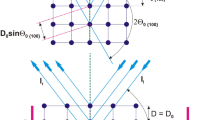Abstract
Residual stresses (RS) can reach significant values in a welded joint, committing the quality of the parts since they affect their resistance to fatigue causing cracks and corrosion under stress. The use of strain gauges positioned in specific zones of welded parts, as a way of mapping the RS values from the welding processes, has a great technological interest. The method proposed in this paper defines strategic positions for strain gauges along ASTM A36 steel plates in butt-welded joints using Gas Tungsten Arc Welding. Helped by a signal conditioner, RS values were collected and registered after welding process. The results are the readings of RS imposed by the welding operation, taking into account thermal process effects and the material properties. Experimental results were compared with numerical analysis, via Finite Element Method which showed the potential use of strain gauges for measuring RS from the welding process.










Similar content being viewed by others
Abbreviations
- C :
-
Specific heat coefficient, J/(kg °C)
- GF:
-
Gauge factor, dimensionless
- H :
-
Heat input, J/mm
- i :
-
Electric current intensity, A
- q 0 :
-
Heat source, J/mm
- R :
-
Electrical resistance, Ω
- t :
-
Thickness of base material, mm
- T m :
-
Plate melting temperature, °C
- T 0 :
-
Initial temperature of the plate, °C
- T p :
-
Temperature peak, °C
- V :
-
Electrical voltage imposed to the weld, V
- vs:
-
Welding speed, mm/s
- y :
-
Distance from the weld bead, mm
- ε :
-
Strain, dimensionless
- η :
-
Coefficient of thermal efficiency, dimensionless
- λ :
-
Thermal conductivity, J/(mm °C)
- ρ :
-
Density of base material, kg/mm3
- e:
-
Relative to elastic strain
- m:
-
Relative to melting temperature
- 0:
-
Relative to initial temperature
- p:
-
Relative to plastic strain
- T:
-
Relative to thermal strain
- total:
-
Relative to total strain
- x :
-
Relative to x direction coordinate
- y :
-
Relative to y direction coordinate
- z :
-
Relative to z direction coordinate
References
Anca A, Cardona A, Risso J, Fachinotti VD (2011) Finite element modeling of welding processes. Appl Math Model 35(2):688–707
Bezerra AC, Rade DA, Scotti A (2005) Finite element simulation of TIG welding: structural analysis. International Congress of Mechanical Engineering, COBEM, Ouro Preto
Chang P, Teng T (2004) Numerical and experimental investigations on the residual stresses of the butt-welded joints. Comput Mater Sci 29(4):511–522
Cortez VHL, Medina GYP, Valdez FAR, Lopez HF (2010) Effects of the heat input in the mechanical integrity of the welding joints welded by GMAW and LBW process in transformation induced plasticity steel (TRIP) used in the automotive industry. Soldagem Inspeção 15(3):234–241
Craig JI (2009) AE3145—electrical resistance strain gauge circuits, Atlanta, p 17 http://www.ae.gatech.edu/people/jcraig/ae3145/Lab2/straingages.pdf. Accessed 26 March 2009
Dong P, Hong JK, Bouchard PJ (2005) Analysis of residual stresses at weld repairs. Int J Press Vessels Pip 82(4):258–269
Excel Sensores (2009) http://www.excelsensor.com.br. Accessed 10 April 2009
Fratini L, Zuccarello B (2006) An analysis of through-thickness residual stresses in aluminium FSW butt joints. Int J Mach Tools Manuf 46(6):611–619
Heinze C, Schwenk C, Rethmeier M (2012) Numerical calculation of residual stress development of multi-pass gas metal arc welding. J Constr Steel Res 72:12–19
Jiang W, Guan X (2013) A study of the residual stress and deformation in the welding between half-pipe jacket and shell. Mater Des 43:213–219
Lu J (1996) Handbook of measurements of residual stress, 1st edn. Fairmont Press, Society for Experimental Mechanics Inc., p 253
Masubuchi K (1993) Residual stresses and distortion. In: Welding, brazing and soldering, ASM handbook. ASM International, vol. 6, pp 1094–1102
Masubushi K (1980) Analysis of welded structures, 1st edn. Pergamon Press, International Series on Material Science and Technology, p 642
Modenesi PJ (2008) Efeitos térmicos do ciclo mecânico (Notas)”. Universidade Federal de Minas Gerais, MG, p 26. http://www.demet.ufmg.br/grad/disciplinas/emt019/tensao_residual.pdf. Accessed 8 November 2010
Pannoni FD (2008) Structural stell, p 7. www.cbcaibs.org.br/downloadsapostilas/Aços_estruturais.pdf. Accessed 24 March 2009
Rodriguez YG, Sola JB, Gil F, Rivalta J (2006) Obtaining of residual stress along weld bead by means of analytic and experimental methods. Soldagem Inspeção 11(2):93–101
Rosenthal D (1941) Mathematical theory of heat distribution during welding and cutting. Weld J 20(5):220–234
Totten G, Howes M, Inoue T (2002) ASM international, residual stress formation processes during welding and joining. In: Handbook of residual stress and deformation of steel ASM handbook. ASM International, pp 391–396
Ueda Y, Yamakawa T (1971) Analysis of thermal elastic–plastic stress and strain during welding. Jpn Weld Soc Trans 2(2):90–100
Yung-Li L et al (2005) Fatigue testing and analysis (theory and practice). Elsevier, USA, p 402
Acknowledgments
The authors would like to thank the SENAI Cimatec for technical support in the experiments, FAPEX for financial support to the project research and Tiara Pimentel for their help in the experiments.
Author information
Authors and Affiliations
Corresponding author
Additional information
Technical Editor: Lavinia Borges.
Rights and permissions
About this article
Cite this article
Magalhães, R.R., Junior, A.B.V. & Barra, S.R. The use of conventional strain gauges evaluation for measurements of residual stresses in welded joints. J Braz. Soc. Mech. Sci. Eng. 36, 173–180 (2014). https://doi.org/10.1007/s40430-013-0082-2
Received:
Accepted:
Published:
Issue Date:
DOI: https://doi.org/10.1007/s40430-013-0082-2




